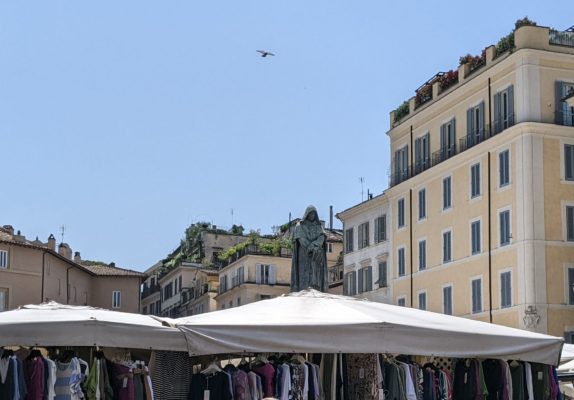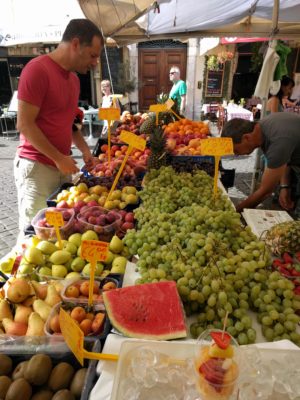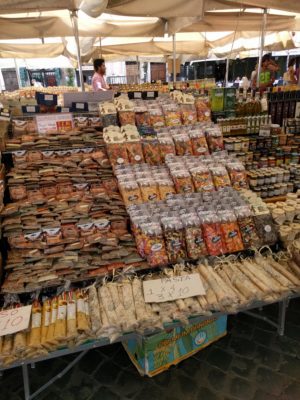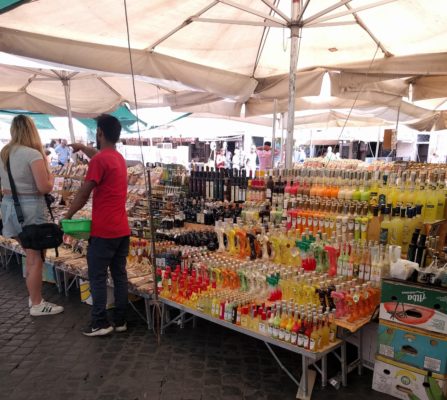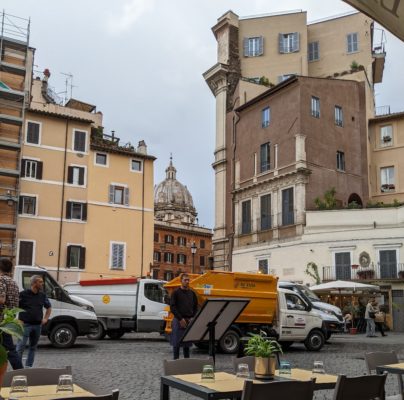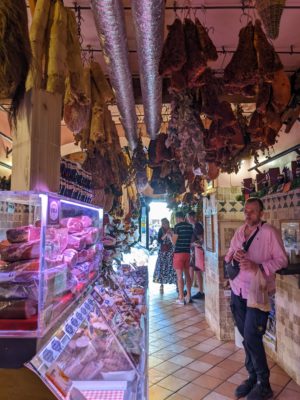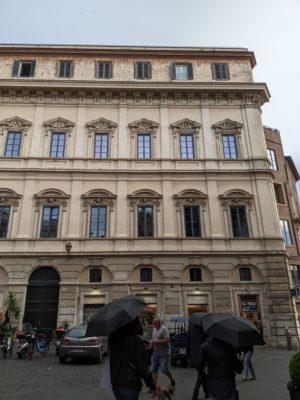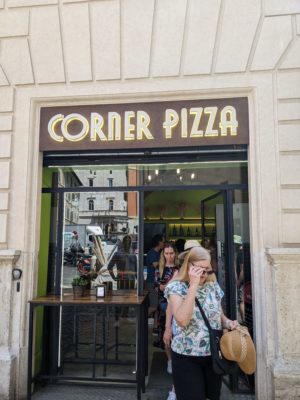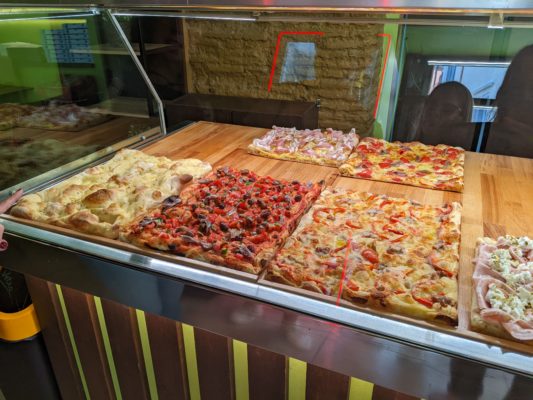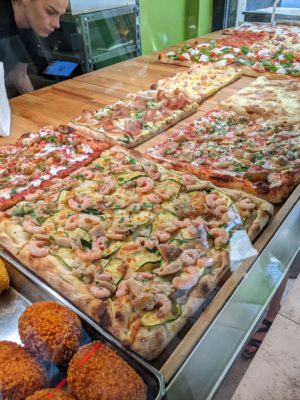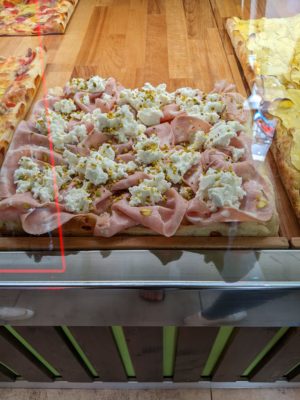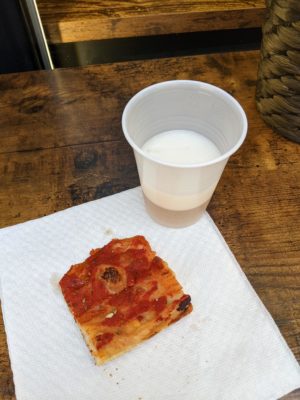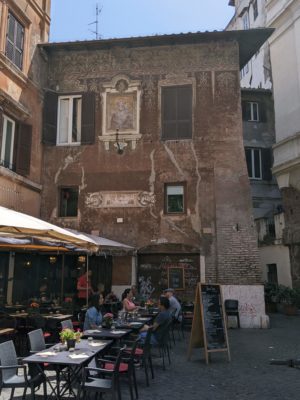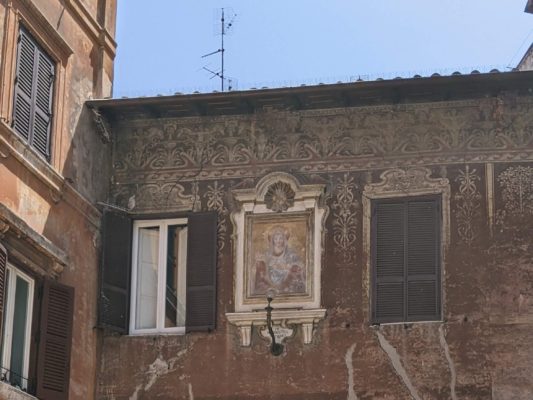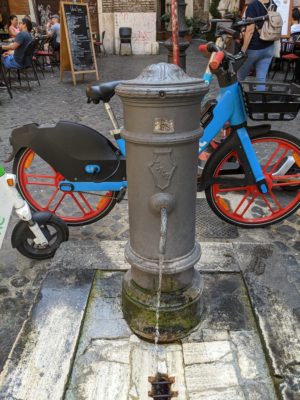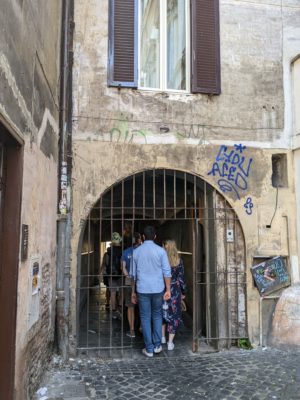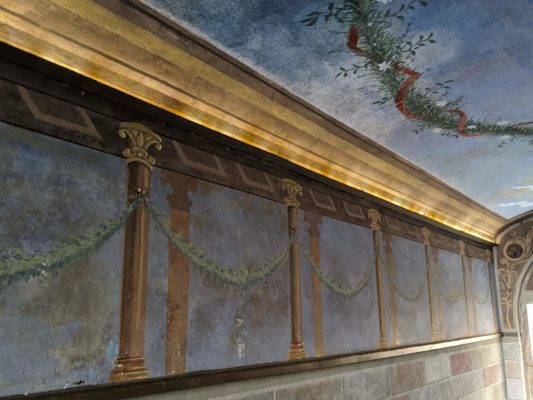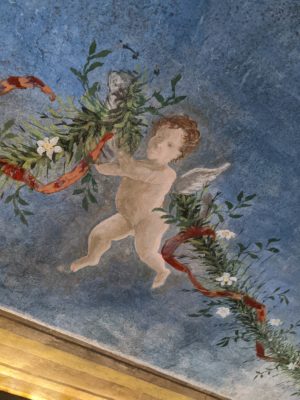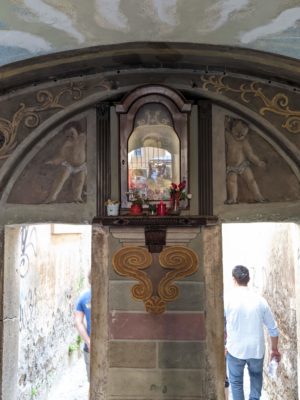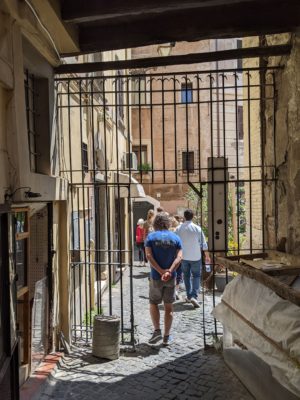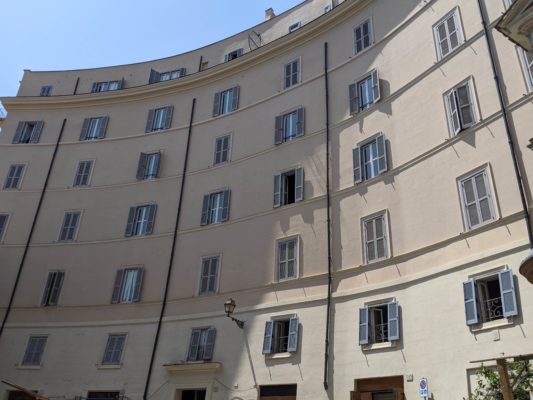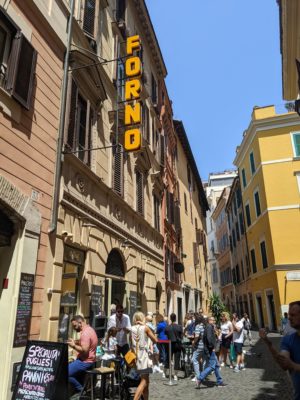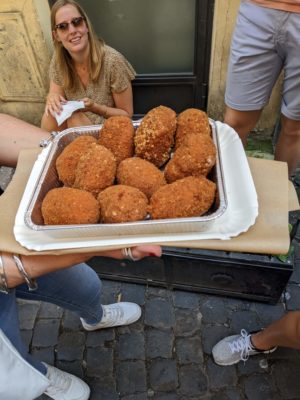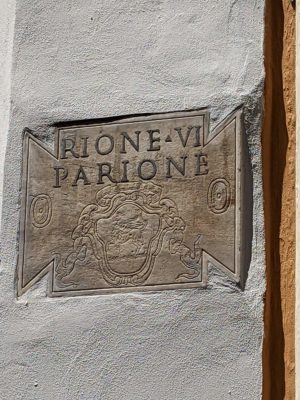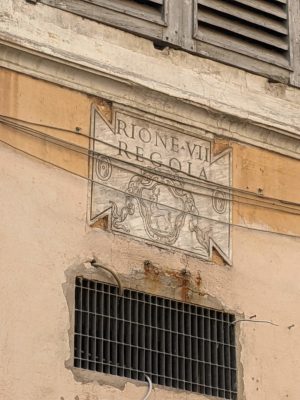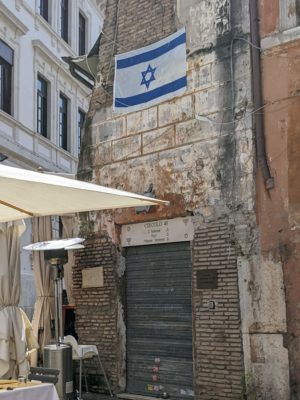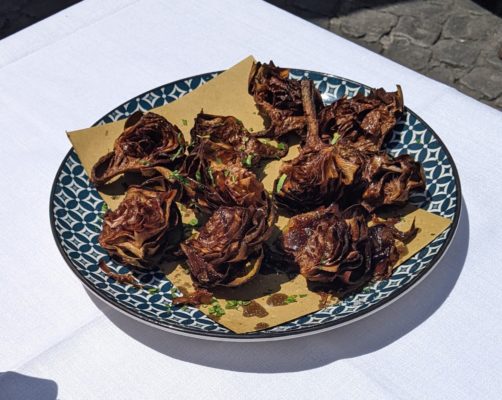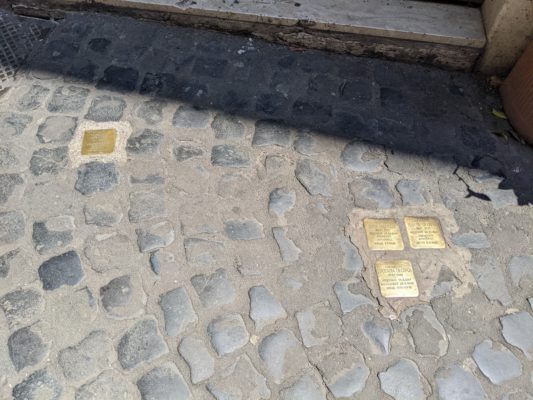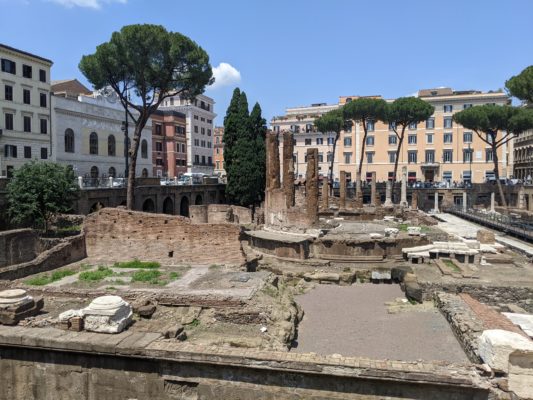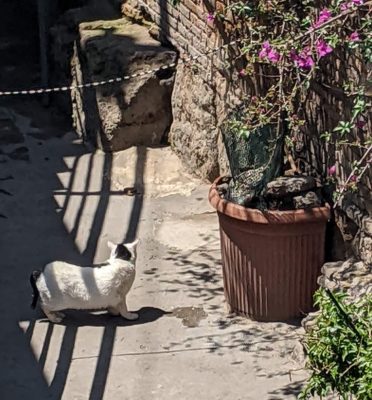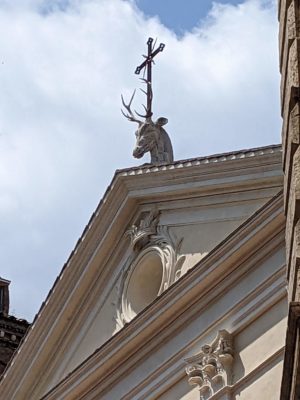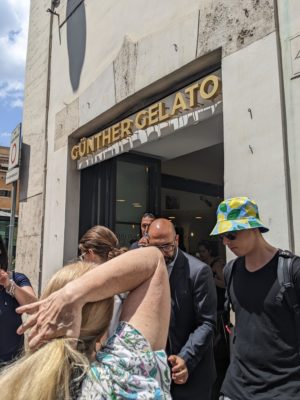Most people people have heard of Airbnb. Lesser known are Airbnb Experiences. These are curated events hosted by locals, and they include events such as walking tours, painting classes, cooking lessons, and other options. While in Madrid in 2019, Chad and I signed up for an experience that included a drive through the countryside, a hike along a ridge overlooking a river valley, and a traditional Spanish lunch at the hosts’ house in a small village outside of Madrid. Chad also did a guided pub crawl with the hosts on another afternoon in Madrid. Last year, Chad and his family did a wine tasting and lunch experience at a farm outside of Florence. We’ve done similar events (not Airbnb) with our friend Claudio in the Cinque Terre – two wine tastings and two cooking classes. Every event has been well worth the time and money. We always learn so much and get to meet people from other countries.
While in Rome, we signed up for a street food tour. It cost 30 euros apiece for a 2-1/2 hour guided walking tour and included the cost of food and drink tastings. In addition to trying street foods, our guide gave us lessons about food, history, culture, and architecture along the way. We absolutely loved it. If you’re curious, it was this tour:
https://www.airbnb.com/experiences/3756484
The tour started in Campo de Fiori Piazza where we got a history lesson. Campo de fiori means “field of flowers,” and this area was originally, well, a field of flowers, before being paved over. During the Inquisition, the piazza was the site of the trials and executions. This is why you don’t find any churches on the square. The statue in the center commemorates a friar who was a philosopher and free thinker and was burned at the stake for being deemed by the Catholic Church as too dangerous. The statue looks towards the Vatican, as if to say, “I have my eye on you.”
Today, the piazza is the location of a major market where you can buy fruits and vegetables, meats, cheeses, limoncello, clothes, jams and pesto, oils, trinkets, and all manner of other things.
The market is open seven days a week from 8 or 9 am until 5 pm. After the market closes for the day, the trash trucks and street sweepers come in to clean the square, and then, as our guide says, “it is a market of Aperol spritz and aperitivi” for happy hour.
Our first food stop was a family-owned cured meat shop where everything is made from the pig. We tried five different products served with a glass of chilled red wine.
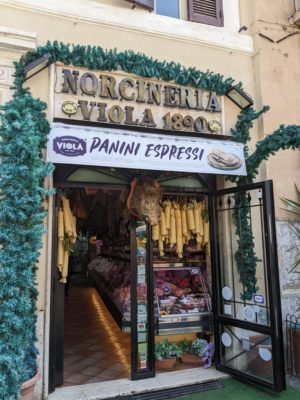
the entrance to the salumi shop – Norcineria means that it is in the style of the town of Norcia, Viola is the family name, and the shop has been around since 1890
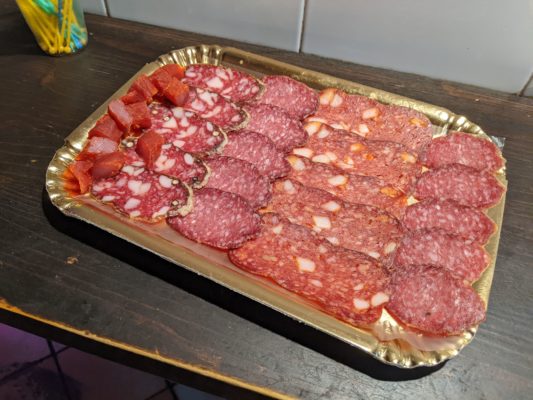
our salumi tasting plate – I don’t remember all of the descriptions, but the chunks on the left are part of a big meat stick, the next is typically eaten at Easter, the third is made with Barolo wine, the fourth was delicious, and the far right is made with truffles
As we left the piazza, our guide pointed out a Renaissance palazzo (mansion) that reused columns from a Roman theater as part of its construction.
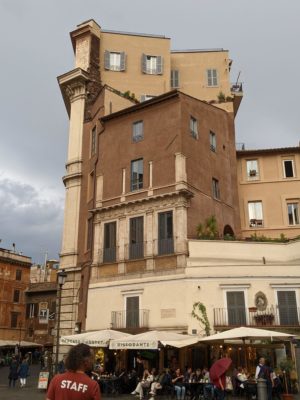
a view of the side where you can see the reused columns – Architectural observation: the dark brown construction and the mustard yellow portion above are newer construction and not part of the original palazzo
Our next stop was a pizza shop. Unlike a pizzeria where you sit down and eat, this shop prepares pizza sliced to go. Roman-style pizza has a thin, crispy crust. We tried three different pizzas served with a glass of cold Peroni beer.
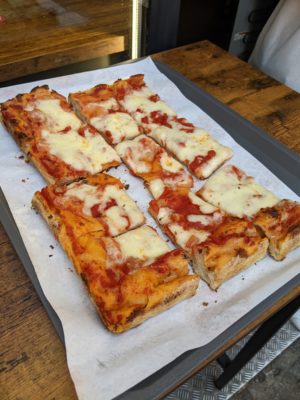
the next was margherita, named after the first queen of Italy, Margherita, after Italy was unified in 1871
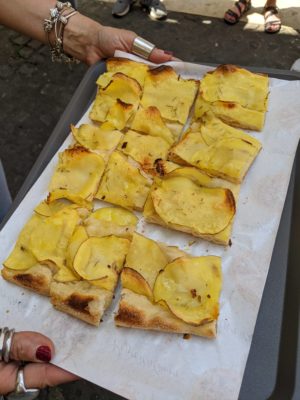
our last taste was potato pizza – just pizza crust and potatoes, fresh out of the oven and piping hot
As we left the pizza shop, we saw this Medieval building with a fresco of the Madonna on it. (Notice the uplight mounted underneath the painting.) During the Medieval times, it was dangerous to travel after dark with limited lighting. It is rumored that people would walk from Madonna to Madonna to have some light to travel by and, hopefully, some safety.
Right in front of the Madonna building was one of Rome’s public drinking fountains. These fountains run 24 hours a day and are a good place to fill your water bottle with fresh, cold water. A fountain is called a nosone (meaning “big nose”) because of the size of the spout. The spout also has a hole on the top that, if you use two fingers to block the spout on the bottom, water will shoot out of the top to make a drinking fountain. Genius! The fountains also have QR codes (that cream-colored tag) that take you to a map showing the location of all of the drinking fountains in the city.
Next to the Madonna building is the Passetto del Biscione. Biscione is the name of the family that built the mansion, and “passetto” means “little passageway.” The passetto has a gate at either end to closed it off at night to protect the frescoes in the passetto.
Next we stopped in a plaza that used to be a Renaissance (I think) theater. The theater is no longer there, but the curve of the palazzo walls helps you imagine what it was like. We were standing on what used to be the stage.
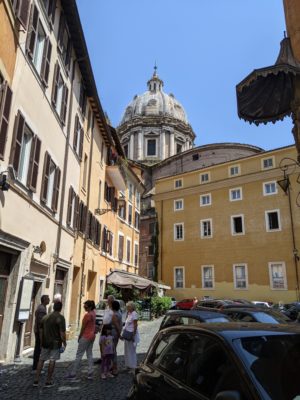
from this piazza, you can see this church which is 80 meters tall, and only Saint Peter’s at the Vatican has a taller dome in Rome
Next food stop – a “forno” which is one name for a bakery. (“Forno” literally means “oven.”) Here we had suppli which are made with tomato risotto and mozzarella, coated in bread crumbs, and then fried. Yum! Rome was part of Napoleon’s empire in the 18th century. French soldiers would eat these fried treats, and when they discovered the mozzarella inside, they would exclaim, “Quelle surprise!” (What a surprise!) The Italians heard, “Suppli!” and now that is the name.
Roman Emperor Augustus divided the city of Rome into 14 districts. We stopped at an intersection of small streets where three districts came together. Plaques on the building walls indicate the names of the ancient districts.
Our next stop was in the Jewish ghetto. This was designated as the Jewish neighborhood in 1555 by the Catholic Church (who ruled Rome and central Italy at the time), and all Jews were forced to move here. Jews could leave the neighborhood during the day, but men had to wear yellow hats and women had to wear yellow head scarves. They all had to return to the ghetto before dark when the gates surrounding the neighborhood were closed for the night.
This practice was in place until 1871 when Italy become a secular kingdom and the Catholic Church no longer ruled Rome. At this time, Jews were allowed to move to other neighborhoods. Many relocated to the other side of the Tiber River to the neighborhood called Trastevere. “Tras” means “across” and “Tevere” means “Tiber.” Across the Tiber River.
To this day there are still a lot of Jewish families here, but there are also people of other faiths as well. There are plenty of kosher restaurants and bakeries and such good smells. The Jews were limited in the work that they were allowed to perform. One of these was fishmonger since the ghetto is located right next to the Tiber River. As a result, you can also find lots of fish on the menus of the restaurants in the neighborhood.
Our fourth food stop was at one of the Jewish restaurants. We had carciofi alla giudia – Jewish-style artichokes. The outer, tough leaves of the artichoke are removed, and then the whole artichoke is fried, twice, in sunflower oil. The result is a delicious, crispy treat.
On the way out of the neighborhood, we stopped to look at some gold cobblestones in the street. During WWII, Italy didn’t follow the nazi protocols for Jews. In fact, Jews were given sanctuary in churches, Catholic churches. Well, the nazi regime didn’t like this, and on October 16, 1943, they marched into the ghetto and rounded up all of the Jews, 1000 of them, and sent them to Auschwitz. Only 17 survived to the end of the war.
Each gold cobblestone is in front of a house where a Jew was rounded up. The stone gives the person’s name, date of birth, and date of exportation (almost all Oct 16, 1943.) The tradition today is the rub your foot across the cobblestone to polish and let the person know that they are not forgotten.
On the way to our final food stop, we past the Piazza Torre di Argentina. This was the site of five Roman temples, and excavation is still underway. Archeologists have determined that Julius Caesar was murdered under the tall pine tree on the left in the photo.
This area is also a cat sanctuary with a staff that feeds and cares for the cats. Of course, every time we walk by this site, I have to stop and look for cats.

there is a white cat in the top left of the photo and another white and gray cat at the bottom right under the table
On the way to our final stop, I saw this church with a deer head on top. Why? I have no idea.
Our final stop was Gunther Gelato. There is a part of northern Italy right next to Austria where people have German names and still speak German. (This area used to be part of Austria.) The guy who opened this gelato shop comes from this area of Italy.
The gelato is all made in-house with fresh ingredients, no preservatives, no added colors. It has been named as one of the top ice-cream stores in the world. I got a lemon and Chad got orange. By this time it was so hot and sunny outside that I just scarfed down my gelato without taking photos. This gelateria is a couple of blocks away from the Pantheon, and it is worth the detour.
At this point, our tour was over. We came back to the apartment to cool off and rest after all of the walking and sun and heat and carbs. Just before reaching our apartment, we stopped at a little convenience store to buy some cold bottles of beer to take home.
Like our previous Airbnb experiences, this one was great, and I would highly recommend it.
